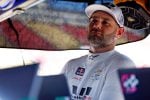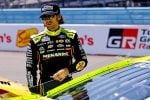The speedway now known as Richmond Raceway has been operational for six decades and conducted its first NASCAR Cup Series event in 1953. At the time, it was known as Richmond Fairgrounds Raceway and was part of the Virginia State Fair.
That was something of a curse.
It meant that the track was beholden to another entity’s officials. It could not make any significant alterations or improvements of any kind without the proper approval.
Which was clearly a thorn in the side of the speedway’s owner, the late Paul Sawyer.
Over the years, Sawyer found it difficult to modernize, or even improve, the track. As mentioned, to do so required official consent – something that was not readily given.
By the 1970s, Richmond was feeling the heat from fans and competitors who complained that the track was substandard due to inadequate facilities. There wasn’t enough parking, there was a lack or restrooms, the garage area was too small and there wasn’t a media center or a functional press box.
Additionally, NASCAR teams regularly complained that the race purses were among the lowest in Cup racing, just slightly more than at Nashville Fairgrounds Speedway, Bristol Motor Speedway and North Wilkesboro Speedway, similar half-mile tracks.
Sawyer was well aware of all this. Indeed, he did make improvements over the years, such as adding parking and seats. It was, overall, very little, but there was very little he could do then.
Rather than beg, Sawyer decided more than once that he would abandon Richmond altogether and become the owner of a larger, more handsome track in another location.
The first proposal in the early 1970s was to construct a superspeedway in Prince George County. Then, in 1978, Sawyer, knowing the Richmond track was woefully lacking, decided to pursue the construction of another superspeedway, this one in Dinwiddie County.
Suffice it to say both projects were abandoned, largely due to the lack of cooperation from financers, political officials and logistics, among other things.
But before the Dinwiddie project was abandoned, Sawyer made a deal with Atlantic Rural Exposition Inc., the lease holder, that would allow him to make massive changes to Richmond over several years.
By 1980, Richmond enjoyed many new improvements, including expanded parking, seating, restroom facilities, a larger garage and infield buildings.
However, that didn’t quell the desire to build a new speedway. In 1985, it was announced that larger track would be built in Isle of Wight County in southern Virginia.
However, those plans were abandoned when NASCAR rejected the request from county officials and associates that the sanctioning body agree to stage two Cup races per season for 15 years.
In June of 1987, Sawyer announced that with the long-absent cooperation of ARE, Richmond would become a 0.75-mile, D-shaped track with many thousands of dollars’ worth of competitor, fan and media facilities.
He was as good as his word. The last race at the 0.524-mile Richmond track was held on Feb. 21, 1988 and won by Neil Bonnett.
The first race scheduled at the new – and most impressive – Richmond track was the Sept. 11 Miller High Life 500.
It was one of the most unusual events in NASCAR lore, largely because of the “Tire Wars” that were raged that year.
Hoosier Tire had entered Cup competition that season and the effect was tremendous. By being in direct competition with Goodyear, it forced teams to adopt new, and sometimes controversial, decisions when it came to competition.
Teams now faced several new questions. Which tire was best for speed? Which was best for durability? Which was superior on each particular track surface?
NASCAR tried to assist, making rules that would allow as much leeway as possible. For example, teams could start on one tire brand and, if needed, switch to the other as a race progressed. That certainly didn’t do much to curtail expenses.
Switching tires played a huge role in the first historic race at the new Richmond.
Hoosier had the fastest tire. Qualifying proved that and teams armed themselves accordingly.
But then, they had their doubts. It evolved that crewmen from most of the Cup teams descended on the NASCAR Xfinity Series race the day before the Cup event.
Their job was to observe and learn how the Hoosiers performed.
I stood in the pit area and saw so many Cup guys, I thought there might be more of them than Busch Series regulars.
They weren’t there long. Very soon, the Hoosiers began to blister. The army of Cup observers quickly ran – yes, ran – to the Goodyear building, where as a mob they began, with arms flailing, to demand tires.
I laughed out loud. The whole thing looked like the floor of the New York Stock Exchange or a 75 percent discount Christmas toy sale at Walmart.
Turns out that 15 teams – the highest number that season by far – acquired Goodyears. And, as dictated by NASCAR rules, they would lose their qualifying positions and be forced to the rear of the field.
The sanctioning body decreed that nearly half the field would be determined by points, which meant some of the fastest qualifiers would lose their positions.
It evolved that Davey Allison, who qualified for the pole on Hoosiers, won the second Cup race of his rookie season in dominating fashion. The strategy formed by his Robert Yates Racing team worked to perfection.
“We took both Goodyears and Hoosiers,” Allison said. “And to tell the truth, we didn’t have enough wheels for all of them. Tommy Ellis was very nice in that he gave us what we needed.
“We decided to start the race on Hoosiers in spite of what we learned. We figured there would be early caution periods. That would benefit the Hoosiers.
“We wouldn’t be forced to pit and then force our way back though the field.”
Sure enough, there were two yellow-flag periods in the first 28 laps. Allison changed to Goodyears during the last and set sail on the restart.
At one point, he led the race by more than 16 seconds. He ultimately led 262 of 400 laps and beat runner-up Dale Earnhardt to the checkered flag by 3.32 seconds.
It wasn’t the most exciting race in Richmond’s history, but the fans who packed the grandstands probably didn’t care.
They were excited by the new-look and much more accommodating track. Richmond was a speedway far removed from what it had been. The race atmosphere was electric.
Richmond has undergone many changes since that race — its seating capacity was once over 102,000) — and it is now owned by the France family.
Which means, of course, that if changes are necessary, permission from another entity is not required.
Steve Waid has been in journalism since 1972, when he began his newspaper career at the Martinsville (Va.) Bulletin. He has spent over 40 years in motorsports journalism, first with the Roanoke Times-World News and later as publisher and vice president for NASCAR Scene and NASCAR Illustrated.
Steve has won numerous state sports writing awards and several more from the National Motorsports Press Association for his motorsports coverage, feature and column writing. For several years, Steve was a regular on “NASCAR This Morning” on FOX Sports Net and he is the co-author, with Tom Higgins, of the biography “Junior Johnson: Brave In Life.”
In January 2014, Steve was inducted into the NMPA Hall of Fame. And in 2019 he was presented the Squier-Hall Award by the NASCAR Hall of Fame for lifetime excellence in motorsports journalism. In addition to writing for Frontstretch, Steve is also the co-host of The Scene Vault Podcast.





